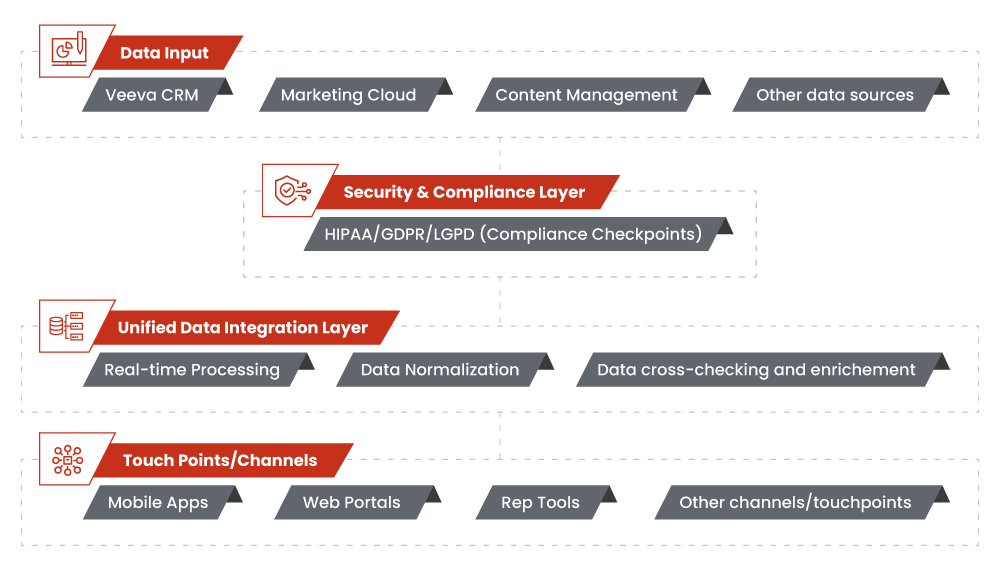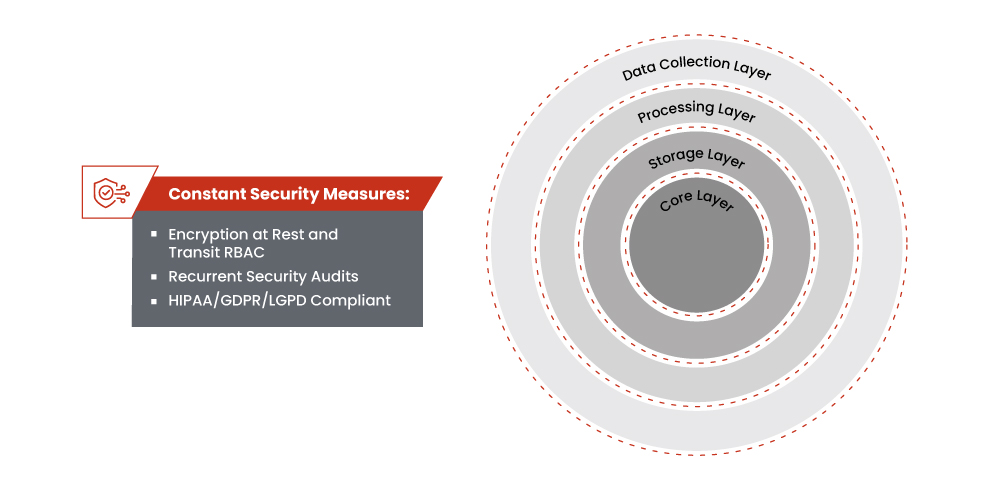Digital Marketing, Digital Production
Healthcare Omnichannel Technical Requirements + Implementation Checklist
Igor Alvarez - Chief Innovation Officer


Welcome to the second article in our four-part series on implementing omnichannel strategies in healthcare communication. In this article, we explained why true omnichannel matters in healthcare. Now we are going to tackle a crucial question: What technical infrastructure makes this omnichannel vision possible?
Setting up an omnichannel communication system in healthcare comes with unique challenges that make the infrastructure especially complex: beyond the usual technical considerations, healthcare organizations must comply with strict regulatory requirements, ensure seamless integration with already existing, top-of-mind medical platforms, and above all maintain the highest standards of data security—all this while delivering a frictionless experience for healthcare professionals and the general public.
While researches from IQVIA indicates that 74% of healthcare organizations understand they need to implement omnichannel solutions [1], only 13% believe their technical infrastructure is ready to handle it [2]. This notable gap between intention and readiness typically comes from organizations being unsure about what technical requirements they need and how to properly implement them.
In this article, we’ll explore together:
- The core technical architecture required for healthcare-compliant Omnichannel systems
- How to integrate frameworks seamlessly with existing healthcare platforms
- Security and compliance considerations unique to healthcare communications
Through practical examples and real-world implementation scenarios, we’ll give you a better understand about how organizations can build robust, compliant, and secure Omnichannel infrastructure that still meets healthcare’s demanding requirements.
Oh, and at the end of the article, you can also grab a free downloadable checklist to guide you in the assessment of your current omnichannel/multichannel implementation process. ☑️
The Core Technical Foundation
The foundation of any successful omnichannel implementation lies in its data architecture, whether it is healthcare-focused or not. But unlike traditional data models, healthcare omnichannel requires a sophisticated unified data architecture that can handle diverse data types while maintaining strict compliance standards:
Data Architecture Requirements
At its core, the data architecture must address three fundamental challenges:
- Data Unification: Combining information from multiple sources (CRMs, CMSs, Social Media
channels for general public communication, marketing platforms, Ads and media buying results, etc.)
while maintaining data integrity and accountability. - Real-time Processing: Enabling immediate data availability across all channels while
ensuring accuracy is the ultimate goal to have a responsive and trustworthy ecosystem that will deliver
to your target the content that they are really looking for at that time. - Compliance Management: Maintaining HIPAA/GDPR/LGPD compliance throughout the entire data
lifecycle is of utmost importance, so it should always be the priority of any strategy aimed at the healthcare
communication segment. If it doesn’t work for the legal/compliance team, it doesn’t work at all.
Here is a simplified architecture diagram that we always use as a starting point when we are designing and explaining an omnichannel infrastructure to our clients:

In this example we have a simple diagram integrating only three data sources (Veeva CRM, Salesforce Marketing Cloud, and a content
management platform) to three different channels (Mobile App, Web Portal and Rep Tools). But in practice the number of channels
may increase a lot according to the client’s current scenario and digital maturity. The only constant is: the unification of data and the need
for a security/compliance layer.
The Unified Data Model
The unified data model acts as the fundamental backbone of any successful healthcare Omnichannel architecture. This structure must be carefully designed to handle all the general requirements of an omnichannel strategy while maintaining the highest standards of security and efficiency needed in the healthcare industry. Here’s a quick summary of the aspects that we take in consideration while elaborating this architecture:
- Comprehensive Data Standardization:
- Convert diverse data formats from multiple sources (CRMs, user behavior, REPs
interaction, enterprise systems, social listening, ads results, etc.) into a
unified, consistent structure - Implement robust data validation rules to ensure accuracy, completeness and
robustness to absence-of-data corner cases. - Maintain detailed metadata tracking for audit purposes
- Anonymization of all required PII data to comply with local legal requirements.
- Convert diverse data formats from multiple sources (CRMs, user behavior, REPs
- Intelligent Relationship Management:
- Create sophisticated mappings between various healthcare data types (REPs, general public, HCPs, general
marketing effort engagements, etc.) - Establish clear hierarchical relationships for the data while maintaining data independence and
auditability - Enable dynamic cross-referencing capabilities for comprehensive macro strategic views of the current
marketing
efforts
- Create sophisticated mappings between various healthcare data types (REPs, general public, HCPs, general
- Advanced Real-time Processing:
- Implement high-performance data layers for immediate information retrieval and triggering of conditional
actions on platforms, whenever its possible - Maintain comprehensive audit trails and version control for uploaded and modified contents to any and
every platform inside of the ecosystem. - Support both real-time and historical data visualization with custom-made dashboards and reports, that
will serve as a tool for rapid decision-making processes, whenever they are needed.
- Implement high-performance data layers for immediate information retrieval and triggering of conditional
- Security-First Data Sharing:
- Enforce role-based access control (RBAC) across all systems
- Implement protection and encryption by default, at all sensible data points (both at rest and in
transit) and reasonably-enforced protection at non-critical stored data - Provide granular audit logging for all data access and modifications
- Use compliant and homologated infrastructure providers, localized on compliant regions and avoid data
transit outside of the original region/country.
The final, implemented, data model may vary according to the requirements and current state of digital implementation of the given client, but the list above serves both as the foundation and a constant checkpoint as we implement a seamless communication across all channels. The final goal is to ensure regulatory compliance and data integrity throughout the entire ecosystem, while making it performant and frictionless to the end-user.
The need for integration
The healthcare industry presents its unique integration challenges that go beyond typical enterprise software implementation. While many industries can take a more straightforward approach to system integration, healthcare demands a more balanced, down-to-earth approach that can connect and work just the same with both legacy systems, general-use platforms, and cutting-edge, new digital solutions. And do all this while maintaining strict compliance standards. It is not exactly an easy task, but there are solutions and strategies that can be very helpful in that regard.
For instance, the Veeva ecosystem, which has become a standard in the healthcare segment communications, deserves a closer look in any integration scenario. Rather than treating it as just another regular/needed-by-default data source, successful implementations always leverage its built-in capabilities/resources. Not just because Veeva is compliant by default with what most organizations legally require, but because it also features many solutions that are tailor-made (and constantly updated) to the pharmaceutical segment’s reality. For example, having a video-call platform, already integrated with a Visual Aid displaying platform, which has everything the REP need to inform the HCPs with the most up-to-date scientific content, pre-approved by the company, and being able to, at the end of the meeting, send a recap email directly to the HCP’s inbox, signed and customized based exactly on the interaction they just had. That’s definitely no small feat even for a combination of different frameworks and platforms, let alone for a single tool (which has already built-in, compliant and consolidated data structure and auditioned approval processes).
But expanding the communication beyond a couple of tool is also a requirement in a vast majority of the cases, so we should always look to keep this kind of elegance and integration with all the channels present in the strategy. CRM/legacy systems require special consideration due to their role in maintaining sensitive customer relationships data. The integration process must support bi-directional data flow by default from/to those systems, while ensuring that sensitive information is properly segregated (anonymized, if needed) and protected both at rest and in-transit. This becomes particularly crucial when dealing with international markets, where varying privacy regulations may affect how customer data can be processed and shared.
And if all those challenges aren’t enough, we must implement seamless connections between tools, channels, and datapoints while ensuring a frictionless and responsive end-user experience. For example, an Accenture Interactive study—“Masters of Mobile” commissioned by Google—revealed that a one‐second delay in page load time results in a 20% fall in conversions and that 53% of users abandon a site if it takes longer than three seconds to load [3]. It is important to remember that even healthcare professionals (HCPs) remain regular internet users, with research by Indegene showing that they demand the same fast, responsive digital interactions as any consumer [4]. Thus, keeping response times low and system uptime high (exceeding 99%) is an absolute necessity for any digital channel within a Healthcare Omnichannel strategy.
Implementation Success Story
To illustrate these concepts in practice, consider a recent implementation for a global healthcare organization we did. This organization faced a common challenge: integrating their newly-existing Veeva CRM system with a new HCP-focused multi-format content platform and other different communication channels (such as the traditional email, local messenger app, in-person visitation, among others) while maintaining compliance across multiple countries of a region. The technical team approached this challenge through a carefully planned, phased implementation: The initial phase focused on establishing a secure integration framework that could handle data from multiple sources while maintaining strict compliance requirements. We chose the best combination of security, reliability and tools already used by the client not only to comply with both security and legal requirements, but also to gain speed to the overall process, avoiding unnecessary new homologation/commercial steps inside the client company.
After we set the data integration layer, we proceeded to connect not only it to its many data inputs, but to also create new tools/procedures that would send data back from it to all the implemented channels, to both inform the REPs of the doctors preferences, last interactions of the HCP in the platforms, subjects they were more interested in, etc. but to also to customize the experience the doctors had with other channels (such as prioritizing contents in the category/format they previously demonstrated interest in and/or didn’t interact with yet). All of this while keeping everything secure, without a single security incident in more than two years of project and a independently measured uptime of more than 98.3% for the entire system.
Security by Design
The security architecture for healthcare Omnichannel systems must be built on the principle of “security by design.” This means incorporating security measures at every level that handles any sensitive or critical information, from the initial data collection points through to final data presentation. Each layer of the security framework serves a specific purpose while working in harmony with other layers to provide comprehensive protection. Data encryption standards in healthcare must meet or exceed HIPAA, GDPR and LGPD requirements. This includes not only encryption at rest and in transit but also careful management of encryption keys and regular security audits. The access control framework must support role-based access control (RBAC) with granular permissions that can be adjusted based on user context and location and allow for fast revocation of privileges, whenever needed.

This diagram shows the compartmentation of data layers and the constant applied when the data is migrating from one layer to another.
This allows not only for data integrity and more in-depth security, but also to have a more granular and function RBAC (Role Based Access Control).
Key Considerations for a successful implementation
When implementing a healthcare Omnichannel infrastructure, several critical factors emerge as essential for success. First, the foundation must be built with compliance and scalability as core elements, not afterthoughts. This means implementing privacy-by-design principles and establishing clear audit trails from the very beginning. Second, data integration requires sophisticated architecture that can handle real-time processing while maintaining strict privacy standards. Finally, content delivery must be optimized across all channels while maintaining consistency and compliance. Success in healthcare Omnichannel implementation relies heavily on understanding that each technical decision has downstream implications for compliance, performance, and user experience. Organizations must carefully balance these considerations, ensuring that the drive for innovation never compromises security or regulatory compliance.
Looking Forward
In our next article, we’ll explore the analytics and measurement frameworks essential for healthcare Omnichannel success. We’ll examine how organizations can effectively track engagement across channels while maintaining privacy, how to derive actionable insights from compliant data collection, and how to measure efficiency in a healthcare-specific context.
And, as promissed… here it is:
The PDF with a technical implementation checklist ☑️
To help organizations navigate the complex journey of healthcare Omnichannel implementation, we’ve created a comprehensive technical checklist. This is a summarized, boilerplate, version of the full assessment checklist we use ourselves in the Omnichannel projects we implement with our clients.
This PDF covers the critical aspects discussed in this article, from infrastructure requirements to compliance considerations.
Healthcare Omnichannel Technical Implementation Checklist
This checklist serves as a practical tool for both technical teams and decision-makers, helping ensure no critical elements are overlooked during implementation. It includes sections on data architecture, security requirements, integration considerations, and common pitfalls to avoid.
Transform Your Healthcare Communication Infrastructure
At C/Edge, we understand the unique challenges of implementing Omnichannel solutions in healthcare. Our team brings deep expertise in both technical implementation and healthcare compliance, ensuring your communication strategy meets today’s demands while preparing for tomorrow’s challenges. Contact us to discuss how we can help you build a robust, compliant, and scalable Omnichannel infrastructure that delivers measurable results for your organization.
References
[1] IQVIA Time to Take Omnichannel Action https://www.iqvia.com/-/media/iqvia/pdfs/emea/library/whitepaper/time-to-take-omnichannel-action.pdf
[2] IQVIA Medical Affairs’ Next Frontier https://www.iqvia.com/-/media/iqvia/pdfs/library/white-papers/iqvia-medical-affairs-next-frontier-unlocking-omnichannel-engagement_dec2022.pdf
[4] https://www.indegene.com/what-we-think/reports/digitally-savvy-hcp
